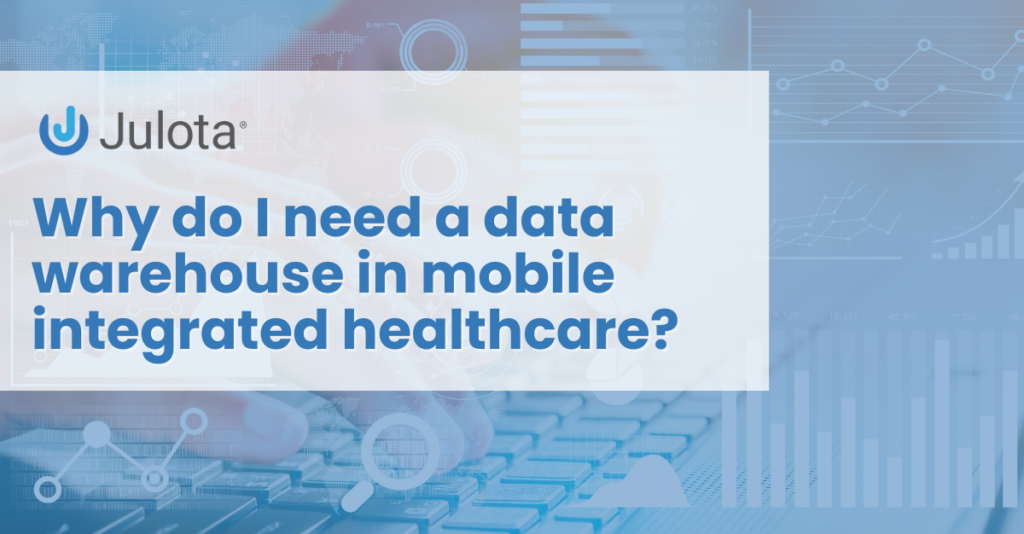Mobile integrated healthcare (MIH) is reshaping how care is delivered—outside hospitals, in homes, on the streets, and across communities. But with that innovation comes a flood of new data: vitals, care plans, assessments, and device readings from multiple sources. The question is—how do you manage it all? This article looks at the role of a data warehouse in mobile healthcare.
Over 80% of healthcare data is unstructured and underused. For mobile healthcare programs to succeed, a robust data warehouse is no longer a luxury—it’s essential.

Why Mobile Integrated Healthcare Needs a Data Warehouse
Without a data warehouse, data lives in silos: ePCRs, EHRs, apps, wearables, billing systems and spreadsheets. MIH teams and clinicians waste time gathering information, leading to delays in care and incomplete pictures of patients. Manual reporting introduces compliance risks, while inconsistent formats make analysis difficult.
A centralized data warehouse solves this by integrating data from across systems, giving providers real-time access to clean, structured information—anywhere they deliver care.
Key Benefits of a Data Warehouse for Mobile Healthcare
1. Streamlined Data Access
A warehouse is a hub aggregating data from wearables, apps, ePCRs, EHRs, and more. For mobile teams, this means secure access to complete patient histories and treatment plans from a tablet or phone—no more toggling between disconnected systems.
2. Real-Time Insights
Live dashboards and predictive analytics help clinicians make faster, smarter decisions. A well-designed warehouse flags patients at risk before symptoms worsen—empowering teams to act proactively, not reactively.
3. Better Care Coordination
With all providers accessing the same data, transitions between mobile visits, hospital stays, and community care are seamless. Duplicate tests are avoided, medication errors are reduced, and treatment plans are unified.
4. Simplified Compliance
Automated audit trails and reporting tools make complying with HIPAA, CFR-42 and grant reporting requirements easier. Instead of hours pulling reports, data is pre-packaged, validated, and ready to submit.
5. Cost Efficiency
Warehouses reduce manual data entry, lower administrative overhead, and help identify resource waste. Insights about where care is most needed allow teams to deploy strategically—maximizing impact while controlling costs.
Cloud-Based Architecture for Mobile Use
Cloud-based data warehouses offer flexibility, scalability, and access on the go. Mobile clinicians can instantly update or retrieve records with a secure internet connection. Pay-as-you-go pricing also helps avoid massive upfront infrastructure costs.
Many programs use hybrid models—storing sensitive PHI in private clouds while using public cloud environments for non-clinical analytics.
Built-in Security and Privacy
Mobile environments introduce new vulnerabilities. Encryption (in transit and at rest), multi-factor authentication, and role-based access controls are critical. Good data warehouses also log who accessed what and when adding a layer of transparency that helps with trust and regulation.
Integration with Mobile Health Tools
MIH relies on more than just ePCRs and EHRs—it uses telehealth, custom apps, remote monitoring tools, and IoT devices. A solid warehouse integrates with all of them, using APIs and standards like FHIR to enable clean, secure data exchange.
Offline data sync—critical in rural or disaster response—is also part of the architecture, letting providers collect data without connectivity and sync once they’re back online.
Implementation Strategy: Where to Start
1. Define Your Objectives
Know what problems you’re solving: Is it slow reporting? Disconnected data? Poor visibility into field operations?
2. Choose the Right Partner
Select a platform designed for healthcare, with mobile-first features, secure access, and integration support. Prioritize usability for field staff.
3. Pilot with a Small Use Case
Don’t go enterprise-wide right away. Start with a high-impact use case—like a chronic care program or grant-based initiative—and scale from there.
4. Train Mobile Teams
Training should focus on practical, on-the-go use. Show value fast—like how fewer clicks and quicker insights save time on the job.
5. Maintain and Improve
Monitor usage, gather feedback, and improve as needs evolve. Plan for quarterly reviews to ensure alignment with goals and tech changes.
Addressing Common Challenges
- Volume Management: Use tiered storage (frequently accessed vs. archival) and compression techniques to decrease costs.
- Security: Implement zero-trust architecture, encryption, and mobile device management to prevent breaches.
- Connectivity: Design for offline-first usage with local caching and delayed sync.
- Cost vs. Performance: Leverage cloud elasticity, track usage metrics, and use serverless or containerized environments when possible.
What’s Next for Data Warehousing in MIH?
The future lies in smarter, more dynamic systems. Expect to see:
- AI & ML: Identifying trends and predicting deterioration before it happens.
- Real-Time Guidance: Field providers get instant, personalized care suggestions.
- Edge Computing: Local processing on mobile devices with seamless sync.
- Blockchain: Secure, transparent data sharing across agencies.
Final Thoughts
Mobile Integrated Healthcare isn’t just a trend—it’s the future. However, your data must be as mobile and intelligent as your teams to deliver care effectively in the field.
A data warehouse is the engine that powers this transformation. Without it, you’re flying blind. With it, you unlock real-time insights, streamlined workflows, and better patient and provider outcomes.